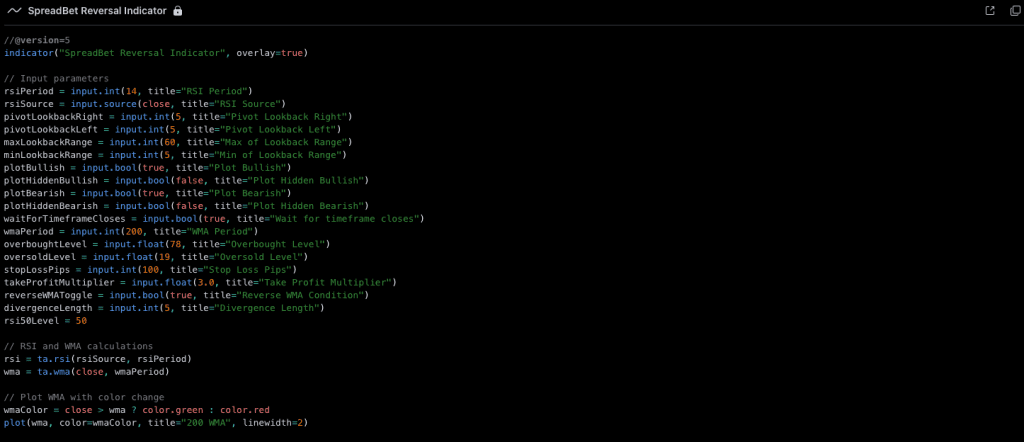The rise of automation has transformed the way both professional and retail traders approach the markets. Automated trading strategies, also known as algorithmic trading (or algo trading), involve using pre-programmed rules to execute trades automatically. These strategies can analyse market data, place orders, and manage positions without requiring constant manual intervention, making them increasingly popular among traders looking for efficiency, speed, and data-driven decision-making.
This comprehensive guide will dive deep into what automated trading strategies are, provide examples of popular algorithms, and explore how to use them for spread betting. We’ll also examine tools like MetaTrader, TradingView’s Pine Script, cTrader’s cBots, and other platforms that support automated trading.
What Are Automated Strategies in Trading?

At their core, automated trading strategies are systems that use algorithms to execute trades on behalf of a trader. The rules that guide these strategies can be based on various market indicators, including price movements, technical analysis patterns, news events, or even market sentiment.
An automated trading system can be as simple as an instruction to buy an asset when its price drops below a certain level and sell when it rises above another. Alternatively, it can be as complex as a multi-factor algorithm that accounts for hundreds of data points and market conditions before making a decision.
Why Use Automated Strategies?
The key advantage of automated strategies is that they allow traders to remove emotions from trading and ensure consistent execution of their trading plans. These systems:
- Remove Emotional Bias: Automated trading systems follow predefined rules, eliminating the emotional interference that often leads to poor trading decisions.
- Increase Speed: They can execute trades in milliseconds, capitalizing on opportunities that would be impossible to capture manually.
- Improve Accuracy: Algorithms are precise, following the strategy exactly as defined without the errors that human traders might introduce.
- Allow for 24/7 Trading: Automated systems can monitor and trade across multiple markets simultaneously, providing global coverage without requiring the trader to be constantly present.
Automated strategies are used across various markets, including stocks, forex, cryptocurrencies, commodities, and increasingly, spread betting.
Examples of Popular Automated Strategies

Automated trading strategies can vary in complexity, from straightforward trend-following systems to sophisticated arbitrage models. Here are a few common examples:
1. Trend-Following Algorithms
Trend-following strategies aim to identify and capitalize on price momentum. These strategies will automatically buy when the price is trending upwards and sell when the trend reverses. Traders often use indicators like moving averages, Relative Strength Index (RSI), and Bollinger Bands to build such systems.
For example:
- A simple trend-following system might buy a stock when its 50-day moving average crosses above its 200-day moving average, signaling an uptrend.
- The system would automatically exit the position if the reverse occurs, indicating the trend has ended.
2. Mean Reversion Algorithms
Mean reversion strategies are based on the principle that asset prices tend to revert to their average over time. If a stock price deviates significantly from its historical average, the system will trade on the assumption that the price will return to that mean.
For instance:
- The algorithm might buy an asset that has dropped well below its historical price range and sell once it reverts to the mean.
3. Arbitrage Strategies
Arbitrage is the practice of profiting from price discrepancies between two or more markets. An arbitrage algorithm seeks out these discrepancies and executes trades to capture profits before the price difference disappears.
A typical example might involve:
- Simultaneously buying an asset in one market where it’s undervalued and selling it in another market where it’s overvalued.
4. High-Frequency Trading (HFT)
High-frequency trading involves the execution of a large number of trades in fractions of a second. These algorithms rely on ultra-fast systems and are typically used by institutional traders. HFT strategies often focus on small price movements across different markets and use advanced latency arbitrage techniques to capitalize on price discrepancies that exist for only milliseconds.
5. News-Based Trading Algorithms
Some automated systems rely on the rapid processing of news events to execute trades. These systems scan news headlines or economic reports for key phrases or data points and react instantly. For example, a news-based algorithm might buy a stock if a positive earnings report is released or sell if a geopolitical event negatively impacts the market.
Automated Trading and Spread Betting

Spread betting is a derivative strategy where you bet on the price movement of an asset without actually owning the asset. In this form of trading, you speculate on whether the price of an asset will rise or fall. The more the price moves in your favor, the more you profit, and vice versa.
Automated trading strategies are particularly well-suited for spread betting because they can handle the complexities of constantly monitoring prices, calculating positions, and managing risk across various markets. Here’s how to integrate automated strategies with spread betting:
1. Using Automated Strategies with Spread Betting
- Setting Parameters: You can create an algorithm that buys or sells based on predefined price points. For example, if you believe that a particular stock will rise if it crosses a certain resistance level, the bot can automatically execute the bet for you.
- Stop-Loss and Take-Profit Levels: Automated systems can efficiently manage stop-losses and take-profit levels, ensuring you exit the market at the right time without emotional interference.
- Leveraging Real-Time Data: Many platforms allow your automated systems to react to real-time data, meaning they can adjust their bets dynamically based on the latest market movements.
2. Why Automation is Ideal for Spread Betting
- Leverage: Spread betting often involves leverage, meaning small price movements can have significant impacts on your balance. Automation helps capitalize on small movements efficiently.
- Volatility: Many spread bettors thrive on volatile markets, where price swings present multiple trading opportunities. Automated strategies ensure you don’t miss these fast-paced changes.
Using MetaTrader and Expert Advisors (EAs) for Automated Trading

MetaTrader 4 (MT4) and MetaTrader 5 (MT5) are among the most popular platforms for automated trading, especially in forex and spread betting. One of their standout features is the ability to use Expert Advisors (EAs), which are custom algorithms you can program to execute trades automatically based on predefined criteria.
Key Features of MetaTrader’s Expert Advisors (EAs):
- Customization: You can write your own EAs in MQL4 or MQL5, MetaTrader’s proprietary coding languages. This gives you the flexibility to create trading algorithms based on your specific strategies.
- Backtesting: EAs can be backtested using historical market data to see how they would have performed in past market conditions. This is a critical feature for optimizing your strategy.
- Automated Execution: Once an EA is deployed, it monitors the market 24/7, executing trades according to its programmed rules.
MetaTrader’s EAs are especially useful for forex trading and spread betting, where market conditions can change rapidly. Traders can build EAs to exploit specific opportunities in these volatile markets, ensuring trades are placed at the right moment without requiring manual intervention.
Using Pine Script in TradingView for Automated Strategies

TradingView is a powerful charting platform used by millions of traders worldwide and supported by multiple brokers like IG, City Index and EightCap. One of its key features is Pine Script, a custom scripting language that allows traders to build and test their own trading strategies and indicators.
What is Pine Script?
- Pine Script is TradingView’s proprietary language for building custom indicators, strategies, and alerts. While it’s not as complex as some programming languages, Pine Script is highly effective for developing automated trading systems.
How to Use Pine Script for Spread Betting Bots
- Strategy Creation: Pine Script enables you to write custom trading strategies based on technical indicators like moving averages, RSI, or MACD. Once you’ve written your strategy, you can apply it to your chart and see how it performs in real-time.
- Alerts and Execution: You can set up alerts based on your strategy, and in some cases, integrate these alerts with your broker for automated trade execution. Although TradingView itself does not support direct trade execution, many brokers provide integrations with TradingView to enable this.
- Backtesting: Like MetaTrader, TradingView allows you to backtest your strategy to see how it would have performed under historical market conditions. This is critical for optimizing your spread betting bot.
TradingView is widely regarded for its user-friendly interface and community-driven scripts, making it accessible for both beginners and experienced traders.
A Quick Word on cTrader, cAlgo, and cBots

Another highly effective platform for automated trading is cTrader, which offers cAlgo for creating and deploying cBots. cBots are fully automated trading algorithms that you can program to follow specific trading strategies.
What Are cBots and cAlgo?
- cAlgo is the algorithmic trading interface within cTrader, a popular trading platform used by forex and spread betting traders. It allows you to write and deploy automated trading algorithms using C#, a widely-used programming language.
- cBots are automated trading systems developed using cAlgo. They allow you to trade various instruments, including forex pairs, indices, and commodities, by executing orders based on real-time market data.
Why Are cBots Effective for Automated Trading?
- High Customizability: cBots allow traders to customize their trading strategies using the C# programming language. This makes them highly flexible and powerful for creating complex, multi-layered strategies.
- Fast Execution: The low-latency infrastructure of cTrader ensures that trades are executed with minimal delay, making cBots ideal for strategies that require high-speed execution, such as scalping or high-frequency trading (HFT).
- Backtesting and Optimization: Like MetaTrader’s EAs, cBots can be backtested on historical data to optimize performance. The platform also allows for optimization, which tests various parameters within the strategy to find the most effective settings.
Using Pepperstone to Trade with cBots

One of the leading brokers that supports cTrader and cBots is Pepperstone. Pepperstone is a well-known broker that offers access to a wide range of markets, including forex, indices, and commodities. The broker integrates seamlessly with cTrader, allowing you to use cBots to automate your spread betting and forex trading.
Pepperstone’s cTrader platform is known for its:
- Fast execution speeds, making it suitable for scalping and high-frequency trading.
- Advanced charting tools, which help traders develop and refine automated strategies.
- User-friendly interface, even for beginners new to automated trading.
- Low-latency environment, reducing slippage and ensuring more accurate trade execution.
By using Pepperstone’s cTrader platform, traders can build, test, and deploy their own cBots for real-time trading in various financial markets.
Choosing the Right Platform for Automated Spread Betting

There are many platforms available for automated trading, each with its strengths. Here’s a quick comparison:
- MetaTrader: Ideal for forex traders and spread bettors who want to use Expert Advisors and prefer a robust, well-established platform. It’s highly customizable but requires knowledge of the MQL programming languages.
- TradingView: Best suited for traders looking for an intuitive, web-based platform with extensive charting capabilities. While it’s not as advanced for automation as MetaTrader, Pine Script is a great tool for developing custom strategies and indicators.
- cTrader: Another popular platform that supports cBots, customizable trading bots built using C#. It’s highly versatile and is particularly well-suited for traders comfortable with programming.
Conclusion

Automated strategies have revolutionized modern trading, allowing traders to harness the power of algorithms to execute trades quickly and accurately without human intervention. Whether you’re using MetaTrader’s Expert Advisors, TradingView’s Pine Script, or another platform, the key to success is crafting a well-thought-out strategy that suits your trading goals and market conditions.
For spread bettors, automation offers a significant advantage by streamlining trade execution, managing risks, and ensuring that decisions are data-driven rather than emotional. However, it’s important to test your strategy thoroughly and optimize it through backtesting before deploying it in live markets.
By leveraging the right tools and platforms, you can develop a robust and profitable automated trading system that enhances your trading experience and increases your chances of success in the financial markets.
Raw Links for Supporting Sources
- Automated Trading Overview:
- MetaTrader Expert Advisors:
- Pine Script Documentation:
- TradingView Overview:
- Backtesting in Trading:
James is a former FTSE100 AI Director and trader with 10+ years trading his own capital. He is the Managing Director of SpreadBet.AI and currently trades his own capital through both CFD trading & spread betting as well as working with one of the leading prop firms in the world.


![The Best Forex Spread Betting Broker in the UK [2025]](https://spreadbet.ai/wp-content/uploads/2025/05/joshua-mayo-bmj1Vl77ZWM-unsplash-450x338.jpg)


![The Best Forex Spread Betting Broker in the UK [2025]](https://spreadbet.ai/wp-content/uploads/2025/05/joshua-mayo-bmj1Vl77ZWM-unsplash-100x100.jpg)









